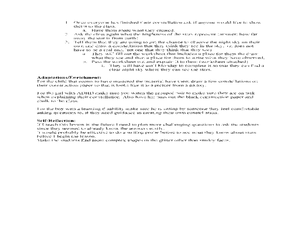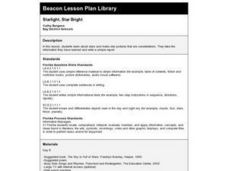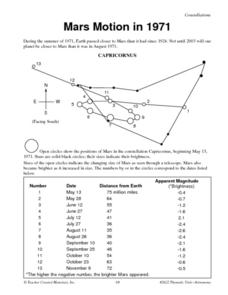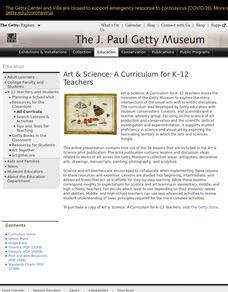Curated OER
Constellations
In this constellations instructional activity, students write their name as a constellation using an x and y-axis graph. This instructional activity has 1 graph to create.
Curated OER
Space Science: Constellations and the Sun
Students review the zodiac signs and illustrate their movement using constellations on the wall and themselves to represent earth. Individually or in groups, they stand in the center of the room while a shadeless lamp is placed between...
Curated OER
Size of Stars
Fifth graders draw constellations in the sky and use the brightness levels of stars to show how big they are. In this constellations lesson plan, 5th graders describe what they see in the night sky by discussing the star's distances.
Curated OER
Star Frames
Fourth graders study constellations. For this space science lesson, 4th graders discover what makes stars, how bright stars are, and why constellations were created. Students make their own constellation using Saran Wrap and a frame.
Curated OER
Sky Pictures
Students investigate constellations. In this space science instructional activity, students view transparencies of constellations and identify the zodiac constellations. Students research the legends connected with the constellations.
Curated OER
Stars and Galaxies
Eighth graders define constellations and how they are used as reference points and identify stars and constellations in the nighttime sky. They construct their own planetarium star finder and identify the location of circumpolar, zodiac,...
Curated OER
Astrology: Fact or Fiction?
Students explore the topic of astrology and review the beliefs behind it. They read sample horoscopes. Using a portable digital planetarium, they view the night sky and the zodiac constellations. They examine and discuss the science...
Curated OER
Star Art
Pupils study about stars, constellations, and myths that accompany them. Then they create their own constellation using black paper and toothpicks and write a myth about their constellation. Their constellation can be viewed on an overhead.
Curated OER
Astrology: Fact Or Fiction?
High schoolers investigate the concept of astrology and how it evolved from history. They use the Zodiac in order to find the location of constellations in the night sky. The differences between astrology and astronomy are compared and...
Curated OER
Observational Astronomy
Students research about the characteristics of celestial bodies using a database. In this space science lesson, students collect data such as brightness, apparent color and size by observing the night sky. They share their findings with...
Curated OER
Starlight, Star Bright
First graders read books and use the Internet to identify several constellations and stars in the night sky. They make star pictures and write a class report about the night sky including a title, complete sentences and a cited reference.
Curated OER
How Do We Know?
Students investigate the history of astronomy and how the study of constellations has evolved since the dawn of ancient civilization. They conduct research using a variety of resources. The teacher uses demonstrations to model how the...
Curated OER
How Do We Know...?
Students identify and explain how various inventions and astronomers have improved our appreciation of the universe. Students identify at least two constellations in the sky and discuss how they were used in ancient times to tell time...
Curated OER
Mars Motion in 1971
For this science worksheet, students read about the summer of 1971 when the Earth passed closer to Mars than it had since 1924. Students also learn about the retrograde motion of Mars as seen from Earth.
Curated OER
Constellation Companions
Learners identify constellations and the characteristics of the stars that compose them. For this space science lesson, students view depictions of Ursa Major and Ursa Minor in the book Astronomical Micelleny. Learners create their own...
Curated OER
Exploring the Constellations, a WebQuest Activity
Students explore space science by participating in a class WebQuest. In this constellation identification instructional activity, students view star charts based on the four seasons and identify the changes our sky goes through in the...
Curated OER
Classifying Stars and Constellations
Students examine stars and constellations. In this space science lesson, students visit selected websites to discover information about the classification of stars. Students also practice identifying constellations.
Curated OER
Planets, Constellations, and Stars
In this space science worksheet, learners find the answers to the research questions that focus on the stars, planets, and constellations.
Curated OER
What's Your Sign? The Science Behind The Zodiac
Students investigate the concepts dealing with the motions of celestial objects, the ancient origins of the Zodiac and the science behind the Zodiac.
Curated OER
Stars
In this language arts/science worksheet, students write about 3 topics: what they know, what they want to know, and what they've learned about stars.
Curated OER
Astronomy Merit Badge
Young scholars explore astronomy through the Starry Night Constellation Adventure software. They print star charts and identify constellations. They sketch the Big Dipper and describe the Milky Way. They list the five most visible...
Curated OER
Using a Starfinder
In this starfinder worksheet, 5th graders construct a starfinder in order to determine which stars are in the night sky on a given date and time. Students use their starfinder to answer 9 questions about the stars and constellations,...
Curated OER
Galaxies and Stars Scavenger Hunt
In this space worksheet, students identify and describe what auroras are in the sky and why they are made up of different colors. Then they explain why stars are born and what happens to them as they get older. Students also name which...
Curated OER
Seeing Stars
Students discover constellations. In this astronomy lesson, students discuss stars in the sky and that a group of stars is called a constellation. Students then create their own constellations by dropping stars onto a black paper, and...

























